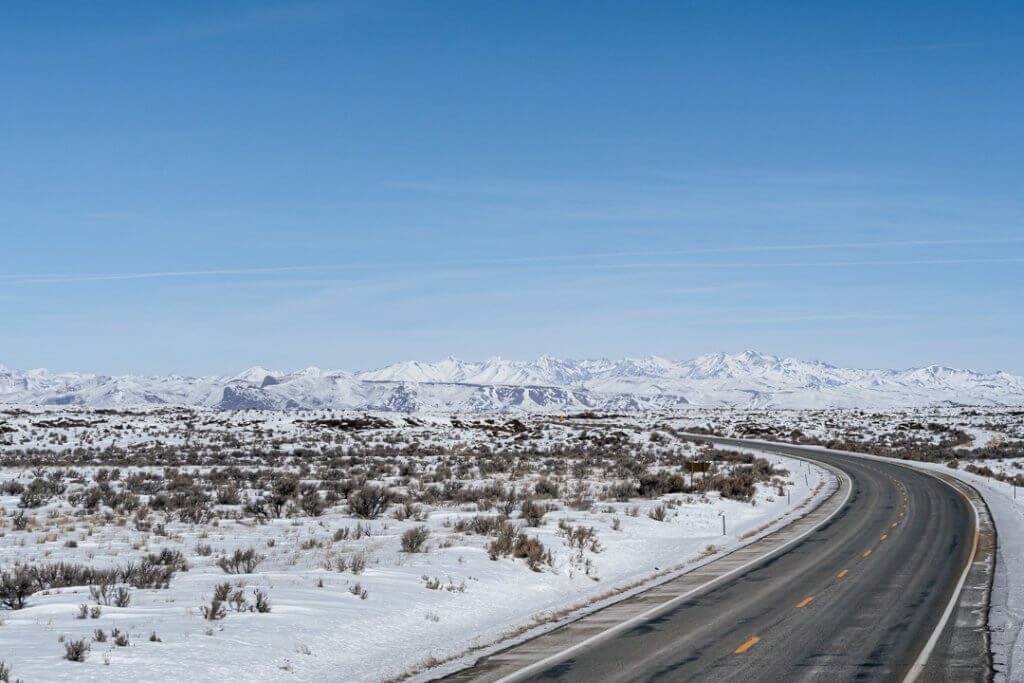Tiffany Burghart worked in partnership with Visit Idaho to create this Travel Tip.
As someone who loves to visit national parks and monuments, Craters of the Moon National Monument and Preserve has been on my radar for a while. Initially, I envisioned us visiting during summer—hiking, exploring the lava caves and maybe even backpacking.
But as someone who also loves off-peak-season travel, I was intrigued when I learned you can find cross-country skiing and snowshoeing in Idaho at Craters of the Moon in winter. Instantly I knew we had to try it, but I also wondered if I would feel like we were missing out by planning our trip during winter. Regardless, we couldn’t think of a better place for our first family snowshoe outing.
Getting to Craters of the Moon

On the day of our visit, as we drove the road from Twin Falls to the park on the Peaks to Craters Scenic Byway, I knew we were in for something special. Towering above the highway, we could see the Sawtooth and Pioneer Mountains in the distance.
On occasion, GPS can be unreliable in this area. Check these directions on how to accurately reach Craters of the Moon ahead of your departure. You will not have to traverse any unpaved roads to reach the visitors center.
Snowshoeing in Idaho at Craters of the Moon
As you approach the park, the change in the terrain becomes apparent. You start to notice large cinder cones rising above the horizon in the distance. We pulled into the parking lot at the visitors center and headed inside to learn a bit more about the history and landscape of the park.

After a brief orientation and snowshoe pickup, we snagged a map and walked straight to the one-mile snowshoe loop on Loop Road that starts only steps from the parking lot. Attaching the snowshoes to our shoes was simple, and even the kids needed minimal help. Moments later, we were on our way.
The one-mile snowshoe loop is relatively easy for beginners. Our snowshoeing pace on this trail was roughly the same as our average hiking pace, though keep in mind that it may vary slightly depending on fresh snowfall and weather conditions. We would estimate 30–60 minutes to complete this loop with kids.
One word to describe our experience? Wow. Simply wow.
I know that can sound cliché, but it was the word that literally all of us kept uttering every time the landscape changed. Yes, even the kids.
There was something incredibly magical about the juxtaposition of the volcanic rock and cinder cones against bright blue skies and the blanket of white that had us all in awe.

What to Bring to Craters of the Moon in Winter
The location of the park puts the nearest gas station and restaurant miles away, so you’ll want to plan accordingly. Here are a few things we suggest having with you in advance:
- A full tank of fuel
- Plenty of snacks and water
- Tire chains in case of challenging winter road conditions
- A basic winter emergency kit including extra layers, food, water and blankets just in case

Planning Tips for Craters of the Moon in Winter
- Dogs are not allowed on the groomed ski track.
- If you don’t have your own snowshoes, you can borrow them from the visitors center Wednesday through Sunday from 9 a.m. to 2 p.m. A $5 donation is suggested for snowshoe rentals.
- During the winter, the Loop Road is closed to most vehicles (including bikes of all types) and becomes the main snowshoe route.
- Free, ranger-led snowshoe hikes happen on Saturdays and Sundays in late January through the month of February. No experience is necessary, and sign up is required in advance.
- Layers are key, as temperatures and wind can vary greatly throughout the day.
My only regret? Not planning to spend more time in Craters of the Moon in winter.
Because of our schedule, we only had an hour or so to explore with our snowshoes. We could easily have spent half a day snowshoeing in Idaho and climbing cinder cones.
Is Craters of the Moon better in winter than summer? I’d venture to say yes, but as there’s only one way to know… With so many warm-weather activities to check out, it sounds like we’ll have to start planning our return trip.
Feature image credited to Tiffany Burghart.
Tiffany Burghart is a blogger, photographer and content creator at The Stoke Fam and on Instagram, where she empowers families to get out and explore together while building stronger relationships with their growing children and tweens.
Updated on December 07, 2023
Published on January 31, 2023
